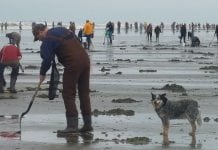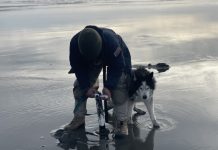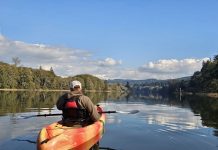This calendar is the place to find fun events happening throughout Grays Harbor County including Aberdeen, Hoquiam, Westport, Ocean Shores, Elma, Montesano and beyond.
Have an event that isn’t listed? Please email events@GraysHarborTalk.com with the following information:
- Name of Event
- Date, time and location (name of business if applicable and complete address)
- Organizer(s) name
- Cost
- URL to purchase tickets
- Website URL
- SHORT description of event
- Photo
Our editors will review and post within a few business days.

The Ryan Villopoto Amateur Motocross Cup (aka: RV Cup) invites riders from around the world to compete on a man-made designed dirt bike course starting from ages 4 and up. From beginners to expert amateur racers will compete over 4 days with the most competitive and well-balanced age group ever in the United States.
Ryan Villopoto is a 10-time American Motorcyclist Association national champion and hails from Washington. His approach off the track since retiring in 2015 is the same as it was on the track. The RV Cup carries his name and provides a safe, competitive environment.

The Ryan Villopoto Amateur Motocross Cup (aka: RV Cup) invites riders from around the world to compete on a man-made designed dirt bike course starting from ages 4 and up. From beginners to expert amateur racers will compete over 4 days with the most competitive and well-balanced age group ever in the United States.
Ryan Villopoto is a 10-time American Motorcyclist Association national champion and hails from Washington. His approach off the track since retiring in 2015 is the same as it was on the track. The RV Cup carries his name and provides a safe, competitive environment.

The Ryan Villopoto Amateur Motocross Cup (aka: RV Cup) invites riders from around the world to compete on a man-made designed dirt bike course starting from ages 4 and up. From beginners to expert amateur racers will compete over 4 days with the most competitive and well-balanced age group ever in the United States.
Ryan Villopoto is a 10-time American Motorcyclist Association national champion and hails from Washington. His approach off the track since retiring in 2015 is the same as it was on the track. The RV Cup carries his name and provides a safe, competitive environment.

The Ryan Villopoto Amateur Motocross Cup (aka: RV Cup) invites riders from around the world to compete on a man-made designed dirt bike course starting from ages 4 and up. From beginners to expert amateur racers will compete over 4 days with the most competitive and well-balanced age group ever in the United States.
Ryan Villopoto is a 10-time American Motorcyclist Association national champion and hails from Washington. His approach off the track since retiring in 2015 is the same as it was on the track. The RV Cup carries his name and provides a safe, competitive environment.

The Ryan Villopoto Amateur Motocross Cup (aka: RV Cup) invites riders from around the world to compete on a man-made designed dirt bike course starting from ages 4 and up. From beginners to expert amateur racers will compete over 4 days with the most competitive and well-balanced age group ever in the United States.
Ryan Villopoto is a 10-time American Motorcyclist Association national champion and hails from Washington. His approach off the track since retiring in 2015 is the same as it was on the track. The RV Cup carries his name and provides a safe, competitive environment.
WDFW approves a six-day razor clam dig starting Tuesday
OLYMPIA – Razor clam diggers can return to ocean beaches for six days of digging beginning Jan. 21.
State shellfish managers with the Washington Department of Fish and Wildlife (WDFW) approved a dig on evening low tides after marine toxin tests showed the clams are safe to eat.
The approved dig is for the following beaches, dates and low tides:
- January 21, Tuesday, 4:23 pm -0.1 feet; Long Beach, Twin Harbors, Mocrocks
- January 22, Wednesday, 5:10 pm -0.5 feet; Long Beach, Twin Harbors, Copalis
- January 23, Thursday, 5:53 pm -0.6 feet; Long Beach, Twin Harbors, Mocrocks
- January 24, Friday, 6:32 pm -0.6 feet; Long Beach, Twin Harbors, Copalis
- January 25, Saturday, 7:08 pm -0.5 feet; Long Beach, Twin Harbors, Mocrocks
- January 26, Sunday, 7:42 pm -0.3 feet; Long Beach, Twin Harbors, Copalis
No digging is allowed before noon for allowed digs, when low tide occurs in the evening.
“Weather and surf during our last opener dissuaded many from participating,” said Dan Ayres, WDFW coastal shellfish manager. “The good news is that this means there are still a great many clams out there for this and future digs.”
For a list of proposed razor clam digs on Long Beach, Twin Harbors, Copalis and Mocrocks beaches through February, please see our razor clam webpage.
Ayres said additional tentative razor clam digs for March and later will be announced in early February.
WDFW authorizes each dig independently after getting the results of marine toxin testing. Final approval of the tentatively scheduled openings will depend on whether results of marine toxin tests show the clams are safe to eat.
In order to ensure conservation of clams for future generations, WDFW sets tentative razor clam seasons that are based on the results from an annual coast-wide razor clam stock assessment and by considering harvest to date. To see videos of WDFW’s sustainable management work for razor clam seasons, visit our razor clam page.
WDFW is also asking razor clam fans around the state to weigh in on the perennial question: Which is better, clam gun or shovel? To register support for a favored digging method, clam diggers can post a photo or video, complete with hashtag #TeamClamShovel or #TeamClamGun on any social media before the end of the spring season.
Additional safety considerations are important this time of year. “Diggers want to be sure to come prepared with good lighting devices and always keep an eye on the surf, particularly at this time of year when low tides come at dusk and after dark,” said Ayres. “Diggers can also start gathering clams an hour or two before the tide, which on some days allows folks to enjoy daylight for most of their time on the beach.”
All diggers age 15 or older must have an applicable 2019-20 fishing license to harvest razor clams on any beach. Licenses, ranging from a three-day razor clam license to an annual combination fishing license, are available on WDFW’s website at https://fishhunt.dfw.wa.gov and from license vendors around the state.
Under state law, diggers at open beaches can take 15 razor clams per day and are required to keep the first 15 they dig. Each digger’s clams must be kept in a separate container.
WDFW is the state agency tasked with preserving, protecting and perpetuating fish, wildlife and ecosystems, while providing sustainable fishing, hunting and other outdoor recreation opportunities.
Persons with disabilities who need to receive this information in an alternative format or who need reasonable accommodations to participate in WDFW-sponsored public meetings or other activities may contact Dolores Noyes by phone (360-902-2349), TTY (360-902-2207), or email (dolores.noyes@dfw.wa.gov). For more information, see https://wdfw.wa.gov/accessibility/requests-accommodation
WDFW approves a six-day razor clam dig starting Tuesday
OLYMPIA – Razor clam diggers can return to ocean beaches for six days of digging beginning Jan. 21.
State shellfish managers with the Washington Department of Fish and Wildlife (WDFW) approved a dig on evening low tides after marine toxin tests showed the clams are safe to eat.
The approved dig is for the following beaches, dates and low tides:
- January 21, Tuesday, 4:23 pm -0.1 feet; Long Beach, Twin Harbors, Mocrocks
- January 22, Wednesday, 5:10 pm -0.5 feet; Long Beach, Twin Harbors, Copalis
- January 23, Thursday, 5:53 pm -0.6 feet; Long Beach, Twin Harbors, Mocrocks
- January 24, Friday, 6:32 pm -0.6 feet; Long Beach, Twin Harbors, Copalis
- January 25, Saturday, 7:08 pm -0.5 feet; Long Beach, Twin Harbors, Mocrocks
- January 26, Sunday, 7:42 pm -0.3 feet; Long Beach, Twin Harbors, Copalis
No digging is allowed before noon for allowed digs, when low tide occurs in the evening.
“Weather and surf during our last opener dissuaded many from participating,” said Dan Ayres, WDFW coastal shellfish manager. “The good news is that this means there are still a great many clams out there for this and future digs.”
For a list of proposed razor clam digs on Long Beach, Twin Harbors, Copalis and Mocrocks beaches through February, please see our razor clam webpage.
Ayres said additional tentative razor clam digs for March and later will be announced in early February.
WDFW authorizes each dig independently after getting the results of marine toxin testing. Final approval of the tentatively scheduled openings will depend on whether results of marine toxin tests show the clams are safe to eat.
In order to ensure conservation of clams for future generations, WDFW sets tentative razor clam seasons that are based on the results from an annual coast-wide razor clam stock assessment and by considering harvest to date. To see videos of WDFW’s sustainable management work for razor clam seasons, visit our razor clam page.
WDFW is also asking razor clam fans around the state to weigh in on the perennial question: Which is better, clam gun or shovel? To register support for a favored digging method, clam diggers can post a photo or video, complete with hashtag #TeamClamShovel or #TeamClamGun on any social media before the end of the spring season.
Additional safety considerations are important this time of year. “Diggers want to be sure to come prepared with good lighting devices and always keep an eye on the surf, particularly at this time of year when low tides come at dusk and after dark,” said Ayres. “Diggers can also start gathering clams an hour or two before the tide, which on some days allows folks to enjoy daylight for most of their time on the beach.”
All diggers age 15 or older must have an applicable 2019-20 fishing license to harvest razor clams on any beach. Licenses, ranging from a three-day razor clam license to an annual combination fishing license, are available on WDFW’s website at https://fishhunt.dfw.wa.gov and from license vendors around the state.
Under state law, diggers at open beaches can take 15 razor clams per day and are required to keep the first 15 they dig. Each digger’s clams must be kept in a separate container.
WDFW is the state agency tasked with preserving, protecting and perpetuating fish, wildlife and ecosystems, while providing sustainable fishing, hunting and other outdoor recreation opportunities.
Persons with disabilities who need to receive this information in an alternative format or who need reasonable accommodations to participate in WDFW-sponsored public meetings or other activities may contact Dolores Noyes by phone (360-902-2349), TTY (360-902-2207), or email (dolores.noyes@dfw.wa.gov). For more information, see https://wdfw.wa.gov/accessibility/requests-accommodation
WDFW approves a six-day razor clam dig starting Tuesday
OLYMPIA – Razor clam diggers can return to ocean beaches for six days of digging beginning Jan. 21.
State shellfish managers with the Washington Department of Fish and Wildlife (WDFW) approved a dig on evening low tides after marine toxin tests showed the clams are safe to eat.
The approved dig is for the following beaches, dates and low tides:
- January 21, Tuesday, 4:23 pm -0.1 feet; Long Beach, Twin Harbors, Mocrocks
- January 22, Wednesday, 5:10 pm -0.5 feet; Long Beach, Twin Harbors, Copalis
- January 23, Thursday, 5:53 pm -0.6 feet; Long Beach, Twin Harbors, Mocrocks
- January 24, Friday, 6:32 pm -0.6 feet; Long Beach, Twin Harbors, Copalis
- January 25, Saturday, 7:08 pm -0.5 feet; Long Beach, Twin Harbors, Mocrocks
- January 26, Sunday, 7:42 pm -0.3 feet; Long Beach, Twin Harbors, Copalis
No digging is allowed before noon for allowed digs, when low tide occurs in the evening.
“Weather and surf during our last opener dissuaded many from participating,” said Dan Ayres, WDFW coastal shellfish manager. “The good news is that this means there are still a great many clams out there for this and future digs.”
For a list of proposed razor clam digs on Long Beach, Twin Harbors, Copalis and Mocrocks beaches through February, please see our razor clam webpage.
Ayres said additional tentative razor clam digs for March and later will be announced in early February.
WDFW authorizes each dig independently after getting the results of marine toxin testing. Final approval of the tentatively scheduled openings will depend on whether results of marine toxin tests show the clams are safe to eat.
In order to ensure conservation of clams for future generations, WDFW sets tentative razor clam seasons that are based on the results from an annual coast-wide razor clam stock assessment and by considering harvest to date. To see videos of WDFW’s sustainable management work for razor clam seasons, visit our razor clam page.
WDFW is also asking razor clam fans around the state to weigh in on the perennial question: Which is better, clam gun or shovel? To register support for a favored digging method, clam diggers can post a photo or video, complete with hashtag #TeamClamShovel or #TeamClamGun on any social media before the end of the spring season.
Additional safety considerations are important this time of year. “Diggers want to be sure to come prepared with good lighting devices and always keep an eye on the surf, particularly at this time of year when low tides come at dusk and after dark,” said Ayres. “Diggers can also start gathering clams an hour or two before the tide, which on some days allows folks to enjoy daylight for most of their time on the beach.”
All diggers age 15 or older must have an applicable 2019-20 fishing license to harvest razor clams on any beach. Licenses, ranging from a three-day razor clam license to an annual combination fishing license, are available on WDFW’s website at https://fishhunt.dfw.wa.gov and from license vendors around the state.
Under state law, diggers at open beaches can take 15 razor clams per day and are required to keep the first 15 they dig. Each digger’s clams must be kept in a separate container.
WDFW is the state agency tasked with preserving, protecting and perpetuating fish, wildlife and ecosystems, while providing sustainable fishing, hunting and other outdoor recreation opportunities.
Persons with disabilities who need to receive this information in an alternative format or who need reasonable accommodations to participate in WDFW-sponsored public meetings or other activities may contact Dolores Noyes by phone (360-902-2349), TTY (360-902-2207), or email (dolores.noyes@dfw.wa.gov). For more information, see https://wdfw.wa.gov/accessibility/requests-accommodation
WDFW approves a six-day razor clam dig starting Tuesday
OLYMPIA – Razor clam diggers can return to ocean beaches for six days of digging beginning Jan. 21.
State shellfish managers with the Washington Department of Fish and Wildlife (WDFW) approved a dig on evening low tides after marine toxin tests showed the clams are safe to eat.
The approved dig is for the following beaches, dates and low tides:
- January 21, Tuesday, 4:23 pm -0.1 feet; Long Beach, Twin Harbors, Mocrocks
- January 22, Wednesday, 5:10 pm -0.5 feet; Long Beach, Twin Harbors, Copalis
- January 23, Thursday, 5:53 pm -0.6 feet; Long Beach, Twin Harbors, Mocrocks
- January 24, Friday, 6:32 pm -0.6 feet; Long Beach, Twin Harbors, Copalis
- January 25, Saturday, 7:08 pm -0.5 feet; Long Beach, Twin Harbors, Mocrocks
- January 26, Sunday, 7:42 pm -0.3 feet; Long Beach, Twin Harbors, Copalis
No digging is allowed before noon for allowed digs, when low tide occurs in the evening.
“Weather and surf during our last opener dissuaded many from participating,” said Dan Ayres, WDFW coastal shellfish manager. “The good news is that this means there are still a great many clams out there for this and future digs.”
For a list of proposed razor clam digs on Long Beach, Twin Harbors, Copalis and Mocrocks beaches through February, please see our razor clam webpage.
Ayres said additional tentative razor clam digs for March and later will be announced in early February.
WDFW authorizes each dig independently after getting the results of marine toxin testing. Final approval of the tentatively scheduled openings will depend on whether results of marine toxin tests show the clams are safe to eat.
In order to ensure conservation of clams for future generations, WDFW sets tentative razor clam seasons that are based on the results from an annual coast-wide razor clam stock assessment and by considering harvest to date. To see videos of WDFW’s sustainable management work for razor clam seasons, visit our razor clam page.
WDFW is also asking razor clam fans around the state to weigh in on the perennial question: Which is better, clam gun or shovel? To register support for a favored digging method, clam diggers can post a photo or video, complete with hashtag #TeamClamShovel or #TeamClamGun on any social media before the end of the spring season.
Additional safety considerations are important this time of year. “Diggers want to be sure to come prepared with good lighting devices and always keep an eye on the surf, particularly at this time of year when low tides come at dusk and after dark,” said Ayres. “Diggers can also start gathering clams an hour or two before the tide, which on some days allows folks to enjoy daylight for most of their time on the beach.”
All diggers age 15 or older must have an applicable 2019-20 fishing license to harvest razor clams on any beach. Licenses, ranging from a three-day razor clam license to an annual combination fishing license, are available on WDFW’s website at https://fishhunt.dfw.wa.gov and from license vendors around the state.
Under state law, diggers at open beaches can take 15 razor clams per day and are required to keep the first 15 they dig. Each digger’s clams must be kept in a separate container.
WDFW is the state agency tasked with preserving, protecting and perpetuating fish, wildlife and ecosystems, while providing sustainable fishing, hunting and other outdoor recreation opportunities.
Persons with disabilities who need to receive this information in an alternative format or who need reasonable accommodations to participate in WDFW-sponsored public meetings or other activities may contact Dolores Noyes by phone (360-902-2349), TTY (360-902-2207), or email (dolores.noyes@dfw.wa.gov). For more information, see https://wdfw.wa.gov/accessibility/requests-accommodation
WDFW approves a six-day razor clam dig starting Tuesday
OLYMPIA – Razor clam diggers can return to ocean beaches for six days of digging beginning Jan. 21.
State shellfish managers with the Washington Department of Fish and Wildlife (WDFW) approved a dig on evening low tides after marine toxin tests showed the clams are safe to eat.
The approved dig is for the following beaches, dates and low tides:
- January 21, Tuesday, 4:23 pm -0.1 feet; Long Beach, Twin Harbors, Mocrocks
- January 22, Wednesday, 5:10 pm -0.5 feet; Long Beach, Twin Harbors, Copalis
- January 23, Thursday, 5:53 pm -0.6 feet; Long Beach, Twin Harbors, Mocrocks
- January 24, Friday, 6:32 pm -0.6 feet; Long Beach, Twin Harbors, Copalis
- January 25, Saturday, 7:08 pm -0.5 feet; Long Beach, Twin Harbors, Mocrocks
- January 26, Sunday, 7:42 pm -0.3 feet; Long Beach, Twin Harbors, Copalis
No digging is allowed before noon for allowed digs, when low tide occurs in the evening.
“Weather and surf during our last opener dissuaded many from participating,” said Dan Ayres, WDFW coastal shellfish manager. “The good news is that this means there are still a great many clams out there for this and future digs.”
For a list of proposed razor clam digs on Long Beach, Twin Harbors, Copalis and Mocrocks beaches through February, please see our razor clam webpage.
Ayres said additional tentative razor clam digs for March and later will be announced in early February.
WDFW authorizes each dig independently after getting the results of marine toxin testing. Final approval of the tentatively scheduled openings will depend on whether results of marine toxin tests show the clams are safe to eat.
In order to ensure conservation of clams for future generations, WDFW sets tentative razor clam seasons that are based on the results from an annual coast-wide razor clam stock assessment and by considering harvest to date. To see videos of WDFW’s sustainable management work for razor clam seasons, visit our razor clam page.
WDFW is also asking razor clam fans around the state to weigh in on the perennial question: Which is better, clam gun or shovel? To register support for a favored digging method, clam diggers can post a photo or video, complete with hashtag #TeamClamShovel or #TeamClamGun on any social media before the end of the spring season.
Additional safety considerations are important this time of year. “Diggers want to be sure to come prepared with good lighting devices and always keep an eye on the surf, particularly at this time of year when low tides come at dusk and after dark,” said Ayres. “Diggers can also start gathering clams an hour or two before the tide, which on some days allows folks to enjoy daylight for most of their time on the beach.”
All diggers age 15 or older must have an applicable 2019-20 fishing license to harvest razor clams on any beach. Licenses, ranging from a three-day razor clam license to an annual combination fishing license, are available on WDFW’s website at https://fishhunt.dfw.wa.gov and from license vendors around the state.
Under state law, diggers at open beaches can take 15 razor clams per day and are required to keep the first 15 they dig. Each digger’s clams must be kept in a separate container.
WDFW is the state agency tasked with preserving, protecting and perpetuating fish, wildlife and ecosystems, while providing sustainable fishing, hunting and other outdoor recreation opportunities.
Persons with disabilities who need to receive this information in an alternative format or who need reasonable accommodations to participate in WDFW-sponsored public meetings or other activities may contact Dolores Noyes by phone (360-902-2349), TTY (360-902-2207), or email (dolores.noyes@dfw.wa.gov). For more information, see https://wdfw.wa.gov/accessibility/requests-accommodation
WDFW approves a six-day razor clam dig starting Tuesday
OLYMPIA – Razor clam diggers can return to ocean beaches for six days of digging beginning Jan. 21.
State shellfish managers with the Washington Department of Fish and Wildlife (WDFW) approved a dig on evening low tides after marine toxin tests showed the clams are safe to eat.
The approved dig is for the following beaches, dates and low tides:
- January 21, Tuesday, 4:23 pm -0.1 feet; Long Beach, Twin Harbors, Mocrocks
- January 22, Wednesday, 5:10 pm -0.5 feet; Long Beach, Twin Harbors, Copalis
- January 23, Thursday, 5:53 pm -0.6 feet; Long Beach, Twin Harbors, Mocrocks
- January 24, Friday, 6:32 pm -0.6 feet; Long Beach, Twin Harbors, Copalis
- January 25, Saturday, 7:08 pm -0.5 feet; Long Beach, Twin Harbors, Mocrocks
- January 26, Sunday, 7:42 pm -0.3 feet; Long Beach, Twin Harbors, Copalis
No digging is allowed before noon for allowed digs, when low tide occurs in the evening.
“Weather and surf during our last opener dissuaded many from participating,” said Dan Ayres, WDFW coastal shellfish manager. “The good news is that this means there are still a great many clams out there for this and future digs.”
For a list of proposed razor clam digs on Long Beach, Twin Harbors, Copalis and Mocrocks beaches through February, please see our razor clam webpage.
Ayres said additional tentative razor clam digs for March and later will be announced in early February.
WDFW authorizes each dig independently after getting the results of marine toxin testing. Final approval of the tentatively scheduled openings will depend on whether results of marine toxin tests show the clams are safe to eat.
In order to ensure conservation of clams for future generations, WDFW sets tentative razor clam seasons that are based on the results from an annual coast-wide razor clam stock assessment and by considering harvest to date. To see videos of WDFW’s sustainable management work for razor clam seasons, visit our razor clam page.
WDFW is also asking razor clam fans around the state to weigh in on the perennial question: Which is better, clam gun or shovel? To register support for a favored digging method, clam diggers can post a photo or video, complete with hashtag #TeamClamShovel or #TeamClamGun on any social media before the end of the spring season.
Additional safety considerations are important this time of year. “Diggers want to be sure to come prepared with good lighting devices and always keep an eye on the surf, particularly at this time of year when low tides come at dusk and after dark,” said Ayres. “Diggers can also start gathering clams an hour or two before the tide, which on some days allows folks to enjoy daylight for most of their time on the beach.”
All diggers age 15 or older must have an applicable 2019-20 fishing license to harvest razor clams on any beach. Licenses, ranging from a three-day razor clam license to an annual combination fishing license, are available on WDFW’s website at https://fishhunt.dfw.wa.gov and from license vendors around the state.
Under state law, diggers at open beaches can take 15 razor clams per day and are required to keep the first 15 they dig. Each digger’s clams must be kept in a separate container.
WDFW is the state agency tasked with preserving, protecting and perpetuating fish, wildlife and ecosystems, while providing sustainable fishing, hunting and other outdoor recreation opportunities.
Persons with disabilities who need to receive this information in an alternative format or who need reasonable accommodations to participate in WDFW-sponsored public meetings or other activities may contact Dolores Noyes by phone (360-902-2349), TTY (360-902-2207), or email (dolores.noyes@dfw.wa.gov). For more information, see https://wdfw.wa.gov/accessibility/requests-accommodation
WDFW approves a six-day razor clam dig starting Tuesday
OLYMPIA – Razor clam diggers can return to ocean beaches for six days of digging beginning Jan. 21.
State shellfish managers with the Washington Department of Fish and Wildlife (WDFW) approved a dig on evening low tides after marine toxin tests showed the clams are safe to eat.
The approved dig is for the following beaches, dates and low tides:
- January 21, Tuesday, 4:23 pm -0.1 feet; Long Beach, Twin Harbors, Mocrocks
- January 22, Wednesday, 5:10 pm -0.5 feet; Long Beach, Twin Harbors, Copalis
- January 23, Thursday, 5:53 pm -0.6 feet; Long Beach, Twin Harbors, Mocrocks
- January 24, Friday, 6:32 pm -0.6 feet; Long Beach, Twin Harbors, Copalis
- January 25, Saturday, 7:08 pm -0.5 feet; Long Beach, Twin Harbors, Mocrocks
- January 26, Sunday, 7:42 pm -0.3 feet; Long Beach, Twin Harbors, Copalis
No digging is allowed before noon for allowed digs, when low tide occurs in the evening.
“Weather and surf during our last opener dissuaded many from participating,” said Dan Ayres, WDFW coastal shellfish manager. “The good news is that this means there are still a great many clams out there for this and future digs.”
For a list of proposed razor clam digs on Long Beach, Twin Harbors, Copalis and Mocrocks beaches through February, please see our razor clam webpage.
Ayres said additional tentative razor clam digs for March and later will be announced in early February.
WDFW authorizes each dig independently after getting the results of marine toxin testing. Final approval of the tentatively scheduled openings will depend on whether results of marine toxin tests show the clams are safe to eat.
In order to ensure conservation of clams for future generations, WDFW sets tentative razor clam seasons that are based on the results from an annual coast-wide razor clam stock assessment and by considering harvest to date. To see videos of WDFW’s sustainable management work for razor clam seasons, visit our razor clam page.
WDFW is also asking razor clam fans around the state to weigh in on the perennial question: Which is better, clam gun or shovel? To register support for a favored digging method, clam diggers can post a photo or video, complete with hashtag #TeamClamShovel or #TeamClamGun on any social media before the end of the spring season.
Additional safety considerations are important this time of year. “Diggers want to be sure to come prepared with good lighting devices and always keep an eye on the surf, particularly at this time of year when low tides come at dusk and after dark,” said Ayres. “Diggers can also start gathering clams an hour or two before the tide, which on some days allows folks to enjoy daylight for most of their time on the beach.”
All diggers age 15 or older must have an applicable 2019-20 fishing license to harvest razor clams on any beach. Licenses, ranging from a three-day razor clam license to an annual combination fishing license, are available on WDFW’s website at https://fishhunt.dfw.wa.gov and from license vendors around the state.
Under state law, diggers at open beaches can take 15 razor clams per day and are required to keep the first 15 they dig. Each digger’s clams must be kept in a separate container.
WDFW is the state agency tasked with preserving, protecting and perpetuating fish, wildlife and ecosystems, while providing sustainable fishing, hunting and other outdoor recreation opportunities.
Persons with disabilities who need to receive this information in an alternative format or who need reasonable accommodations to participate in WDFW-sponsored public meetings or other activities may contact Dolores Noyes by phone (360-902-2349), TTY (360-902-2207), or email (dolores.noyes@dfw.wa.gov). For more information, see https://wdfw.wa.gov/accessibility/requests-accommodation
WDFW approves a seven-day razor clam dig in first weeks of February
State shellfish managers with the Washington Department of Fish and Wildlife (WDFW) approved a dig on evening low tides after marine toxin tests showed the clams are safe to eat.
The approved dig is for the following beaches, dates and low tides:
- February 6, Thursday, 4:40 pm -0.3 feet; Long Beach, Twin Harbors, Mocrocks
- February 7, Friday, 5:26 pm -0.9 feet; Long Beach, Twin Harbors, Copalis
- February 8, Saturday, 6:09 pm -1.3 feet; Long Beach, Twin Harbors, Mocrocks
- February 9, Sunday, 6:51 pm -1.4 feet; Long Beach, Twin Harbors, Copalis
- February 10, Monday, 7:32 pm -1.3 feet; Long Beach, Twin Harbors, Mocrocks
- February 11, Tuesday, 8:13 pm -0.8 feet; Long Beach, Twin Harbors, Copalis
- February 12, Wednesday, 8:55 pm -0.1 feet; Long Beach, Twin Harbors, Mocrocks
No digging is allowed before noon for allowed digs, when low tide occurs in the evening.
“Work to dodge the rain, and this should be a great dig,” said Dan Ayres, WDFW coastal shellfish manager. “Razor clams do not like fresh water, so heavy rain can make them harder to find, but with a bit of patience and good timing it should still be possible to bag limits of clams given the healthy populations across the beaches.”
For a list of proposed razor clam digs on Long Beach, Twin Harbors, Copalis and Mocrocks beaches through February, please see our razor clam webpage.
Ayres said additional tentative razor clam digs for March and later will be announced in early February.
WDFW authorizes each dig independently after getting the results of marine toxin testing. Final approval of the tentatively scheduled openings will depend on whether results of marine toxin tests show the clams are safe to eat.
In order to ensure conservation of clams for future generations, WDFW sets tentative razor clam seasons that are based on the results from an annual coast-wide razor clam stock assessment and by considering harvest to date. To see videos of WDFW’s sustainable management work for razor clam seasons, visit our razor clam page.
WDFW is also asking razor clam fans around the state to weigh in on the perennial question: Which is better, clam gun or shovel? To register support for a favored digging method, clam diggers can post a photo or video, complete with hashtag #TeamClamShovel or #TeamClamGun on any social media before the end of the spring season.
Additional safety considerations are important this time of year. “Diggers want to be sure to come prepared with good lighting devices and always keep an eye on the surf, particularly at this time of year when low tides come at dusk and after dark,” said Ayres. “Diggers can also start gathering clams an hour or two before the tide, which will allow folks to enjoy daylight for most of their time on the beach.”
All diggers age 15 or older must have an applicable 2019-20 fishing license to harvest razor clams on any beach. Licenses, ranging from a three-day razor clam license to an annual combination fishing license, are available on WDFW’s website at https://fishhunt.dfw.wa.gov and from license vendors around the state.
Under state law, diggers at open beaches can take 15 razor clams per day and are required to keep the first 15 they dig. Each digger’s clams must be kept in a separate container.
WDFW is the state agency tasked with preserving, protecting and perpetuating fish, wildlife and ecosystems, while providing sustainable fishing, hunting and other outdoor recreation opportunities.
Persons with disabilities who need to receive this information in an alternative format or who need reasonable accommodations to participate in WDFW-sponsored public meetings or other activities may contact Dolores Noyes by phone (360-902-2349), TTY (360-902-2207), or email (dolores.noyes@dfw.wa.gov). For more information, see https://wdfw.wa.gov/accessibility/requests-accommodation
WDFW approves a seven-day razor clam dig in first weeks of February
State shellfish managers with the Washington Department of Fish and Wildlife (WDFW) approved a dig on evening low tides after marine toxin tests showed the clams are safe to eat.
The approved dig is for the following beaches, dates and low tides:
- February 6, Thursday, 4:40 pm -0.3 feet; Long Beach, Twin Harbors, Mocrocks
- February 7, Friday, 5:26 pm -0.9 feet; Long Beach, Twin Harbors, Copalis
- February 8, Saturday, 6:09 pm -1.3 feet; Long Beach, Twin Harbors, Mocrocks
- February 9, Sunday, 6:51 pm -1.4 feet; Long Beach, Twin Harbors, Copalis
- February 10, Monday, 7:32 pm -1.3 feet; Long Beach, Twin Harbors, Mocrocks
- February 11, Tuesday, 8:13 pm -0.8 feet; Long Beach, Twin Harbors, Copalis
- February 12, Wednesday, 8:55 pm -0.1 feet; Long Beach, Twin Harbors, Mocrocks
No digging is allowed before noon for allowed digs, when low tide occurs in the evening.
“Work to dodge the rain, and this should be a great dig,” said Dan Ayres, WDFW coastal shellfish manager. “Razor clams do not like fresh water, so heavy rain can make them harder to find, but with a bit of patience and good timing it should still be possible to bag limits of clams given the healthy populations across the beaches.”
For a list of proposed razor clam digs on Long Beach, Twin Harbors, Copalis and Mocrocks beaches through February, please see our razor clam webpage.
Ayres said additional tentative razor clam digs for March and later will be announced in early February.
WDFW authorizes each dig independently after getting the results of marine toxin testing. Final approval of the tentatively scheduled openings will depend on whether results of marine toxin tests show the clams are safe to eat.
In order to ensure conservation of clams for future generations, WDFW sets tentative razor clam seasons that are based on the results from an annual coast-wide razor clam stock assessment and by considering harvest to date. To see videos of WDFW’s sustainable management work for razor clam seasons, visit our razor clam page.
WDFW is also asking razor clam fans around the state to weigh in on the perennial question: Which is better, clam gun or shovel? To register support for a favored digging method, clam diggers can post a photo or video, complete with hashtag #TeamClamShovel or #TeamClamGun on any social media before the end of the spring season.
Additional safety considerations are important this time of year. “Diggers want to be sure to come prepared with good lighting devices and always keep an eye on the surf, particularly at this time of year when low tides come at dusk and after dark,” said Ayres. “Diggers can also start gathering clams an hour or two before the tide, which will allow folks to enjoy daylight for most of their time on the beach.”
All diggers age 15 or older must have an applicable 2019-20 fishing license to harvest razor clams on any beach. Licenses, ranging from a three-day razor clam license to an annual combination fishing license, are available on WDFW’s website at https://fishhunt.dfw.wa.gov and from license vendors around the state.
Under state law, diggers at open beaches can take 15 razor clams per day and are required to keep the first 15 they dig. Each digger’s clams must be kept in a separate container.
WDFW is the state agency tasked with preserving, protecting and perpetuating fish, wildlife and ecosystems, while providing sustainable fishing, hunting and other outdoor recreation opportunities.
Persons with disabilities who need to receive this information in an alternative format or who need reasonable accommodations to participate in WDFW-sponsored public meetings or other activities may contact Dolores Noyes by phone (360-902-2349), TTY (360-902-2207), or email (dolores.noyes@dfw.wa.gov). For more information, see https://wdfw.wa.gov/accessibility/requests-accommodation
WDFW approves a seven-day razor clam dig in first weeks of February
State shellfish managers with the Washington Department of Fish and Wildlife (WDFW) approved a dig on evening low tides after marine toxin tests showed the clams are safe to eat.
The approved dig is for the following beaches, dates and low tides:
- February 6, Thursday, 4:40 pm -0.3 feet; Long Beach, Twin Harbors, Mocrocks
- February 7, Friday, 5:26 pm -0.9 feet; Long Beach, Twin Harbors, Copalis
- February 8, Saturday, 6:09 pm -1.3 feet; Long Beach, Twin Harbors, Mocrocks
- February 9, Sunday, 6:51 pm -1.4 feet; Long Beach, Twin Harbors, Copalis
- February 10, Monday, 7:32 pm -1.3 feet; Long Beach, Twin Harbors, Mocrocks
- February 11, Tuesday, 8:13 pm -0.8 feet; Long Beach, Twin Harbors, Copalis
- February 12, Wednesday, 8:55 pm -0.1 feet; Long Beach, Twin Harbors, Mocrocks
No digging is allowed before noon for allowed digs, when low tide occurs in the evening.
“Work to dodge the rain, and this should be a great dig,” said Dan Ayres, WDFW coastal shellfish manager. “Razor clams do not like fresh water, so heavy rain can make them harder to find, but with a bit of patience and good timing it should still be possible to bag limits of clams given the healthy populations across the beaches.”
For a list of proposed razor clam digs on Long Beach, Twin Harbors, Copalis and Mocrocks beaches through February, please see our razor clam webpage.
Ayres said additional tentative razor clam digs for March and later will be announced in early February.
WDFW authorizes each dig independently after getting the results of marine toxin testing. Final approval of the tentatively scheduled openings will depend on whether results of marine toxin tests show the clams are safe to eat.
In order to ensure conservation of clams for future generations, WDFW sets tentative razor clam seasons that are based on the results from an annual coast-wide razor clam stock assessment and by considering harvest to date. To see videos of WDFW’s sustainable management work for razor clam seasons, visit our razor clam page.
WDFW is also asking razor clam fans around the state to weigh in on the perennial question: Which is better, clam gun or shovel? To register support for a favored digging method, clam diggers can post a photo or video, complete with hashtag #TeamClamShovel or #TeamClamGun on any social media before the end of the spring season.
Additional safety considerations are important this time of year. “Diggers want to be sure to come prepared with good lighting devices and always keep an eye on the surf, particularly at this time of year when low tides come at dusk and after dark,” said Ayres. “Diggers can also start gathering clams an hour or two before the tide, which will allow folks to enjoy daylight for most of their time on the beach.”
All diggers age 15 or older must have an applicable 2019-20 fishing license to harvest razor clams on any beach. Licenses, ranging from a three-day razor clam license to an annual combination fishing license, are available on WDFW’s website at https://fishhunt.dfw.wa.gov and from license vendors around the state.
Under state law, diggers at open beaches can take 15 razor clams per day and are required to keep the first 15 they dig. Each digger’s clams must be kept in a separate container.
WDFW is the state agency tasked with preserving, protecting and perpetuating fish, wildlife and ecosystems, while providing sustainable fishing, hunting and other outdoor recreation opportunities.
Persons with disabilities who need to receive this information in an alternative format or who need reasonable accommodations to participate in WDFW-sponsored public meetings or other activities may contact Dolores Noyes by phone (360-902-2349), TTY (360-902-2207), or email (dolores.noyes@dfw.wa.gov). For more information, see https://wdfw.wa.gov/accessibility/requests-accommodation
WDFW approves a seven-day razor clam dig in first weeks of February
State shellfish managers with the Washington Department of Fish and Wildlife (WDFW) approved a dig on evening low tides after marine toxin tests showed the clams are safe to eat.
The approved dig is for the following beaches, dates and low tides:
- February 6, Thursday, 4:40 pm -0.3 feet; Long Beach, Twin Harbors, Mocrocks
- February 7, Friday, 5:26 pm -0.9 feet; Long Beach, Twin Harbors, Copalis
- February 8, Saturday, 6:09 pm -1.3 feet; Long Beach, Twin Harbors, Mocrocks
- February 9, Sunday, 6:51 pm -1.4 feet; Long Beach, Twin Harbors, Copalis
- February 10, Monday, 7:32 pm -1.3 feet; Long Beach, Twin Harbors, Mocrocks
- February 11, Tuesday, 8:13 pm -0.8 feet; Long Beach, Twin Harbors, Copalis
- February 12, Wednesday, 8:55 pm -0.1 feet; Long Beach, Twin Harbors, Mocrocks
No digging is allowed before noon for allowed digs, when low tide occurs in the evening.
“Work to dodge the rain, and this should be a great dig,” said Dan Ayres, WDFW coastal shellfish manager. “Razor clams do not like fresh water, so heavy rain can make them harder to find, but with a bit of patience and good timing it should still be possible to bag limits of clams given the healthy populations across the beaches.”
For a list of proposed razor clam digs on Long Beach, Twin Harbors, Copalis and Mocrocks beaches through February, please see our razor clam webpage.
Ayres said additional tentative razor clam digs for March and later will be announced in early February.
WDFW authorizes each dig independently after getting the results of marine toxin testing. Final approval of the tentatively scheduled openings will depend on whether results of marine toxin tests show the clams are safe to eat.
In order to ensure conservation of clams for future generations, WDFW sets tentative razor clam seasons that are based on the results from an annual coast-wide razor clam stock assessment and by considering harvest to date. To see videos of WDFW’s sustainable management work for razor clam seasons, visit our razor clam page.
WDFW is also asking razor clam fans around the state to weigh in on the perennial question: Which is better, clam gun or shovel? To register support for a favored digging method, clam diggers can post a photo or video, complete with hashtag #TeamClamShovel or #TeamClamGun on any social media before the end of the spring season.
Additional safety considerations are important this time of year. “Diggers want to be sure to come prepared with good lighting devices and always keep an eye on the surf, particularly at this time of year when low tides come at dusk and after dark,” said Ayres. “Diggers can also start gathering clams an hour or two before the tide, which will allow folks to enjoy daylight for most of their time on the beach.”
All diggers age 15 or older must have an applicable 2019-20 fishing license to harvest razor clams on any beach. Licenses, ranging from a three-day razor clam license to an annual combination fishing license, are available on WDFW’s website at https://fishhunt.dfw.wa.gov and from license vendors around the state.
Under state law, diggers at open beaches can take 15 razor clams per day and are required to keep the first 15 they dig. Each digger’s clams must be kept in a separate container.
WDFW is the state agency tasked with preserving, protecting and perpetuating fish, wildlife and ecosystems, while providing sustainable fishing, hunting and other outdoor recreation opportunities.
Persons with disabilities who need to receive this information in an alternative format or who need reasonable accommodations to participate in WDFW-sponsored public meetings or other activities may contact Dolores Noyes by phone (360-902-2349), TTY (360-902-2207), or email (dolores.noyes@dfw.wa.gov). For more information, see https://wdfw.wa.gov/accessibility/requests-accommodation
WDFW approves a seven-day razor clam dig in first weeks of February
State shellfish managers with the Washington Department of Fish and Wildlife (WDFW) approved a dig on evening low tides after marine toxin tests showed the clams are safe to eat.
The approved dig is for the following beaches, dates and low tides:
- February 6, Thursday, 4:40 pm -0.3 feet; Long Beach, Twin Harbors, Mocrocks
- February 7, Friday, 5:26 pm -0.9 feet; Long Beach, Twin Harbors, Copalis
- February 8, Saturday, 6:09 pm -1.3 feet; Long Beach, Twin Harbors, Mocrocks
- February 9, Sunday, 6:51 pm -1.4 feet; Long Beach, Twin Harbors, Copalis
- February 10, Monday, 7:32 pm -1.3 feet; Long Beach, Twin Harbors, Mocrocks
- February 11, Tuesday, 8:13 pm -0.8 feet; Long Beach, Twin Harbors, Copalis
- February 12, Wednesday, 8:55 pm -0.1 feet; Long Beach, Twin Harbors, Mocrocks
No digging is allowed before noon for allowed digs, when low tide occurs in the evening.
“Work to dodge the rain, and this should be a great dig,” said Dan Ayres, WDFW coastal shellfish manager. “Razor clams do not like fresh water, so heavy rain can make them harder to find, but with a bit of patience and good timing it should still be possible to bag limits of clams given the healthy populations across the beaches.”
For a list of proposed razor clam digs on Long Beach, Twin Harbors, Copalis and Mocrocks beaches through February, please see our razor clam webpage.
Ayres said additional tentative razor clam digs for March and later will be announced in early February.
WDFW authorizes each dig independently after getting the results of marine toxin testing. Final approval of the tentatively scheduled openings will depend on whether results of marine toxin tests show the clams are safe to eat.
In order to ensure conservation of clams for future generations, WDFW sets tentative razor clam seasons that are based on the results from an annual coast-wide razor clam stock assessment and by considering harvest to date. To see videos of WDFW’s sustainable management work for razor clam seasons, visit our razor clam page.
WDFW is also asking razor clam fans around the state to weigh in on the perennial question: Which is better, clam gun or shovel? To register support for a favored digging method, clam diggers can post a photo or video, complete with hashtag #TeamClamShovel or #TeamClamGun on any social media before the end of the spring season.
Additional safety considerations are important this time of year. “Diggers want to be sure to come prepared with good lighting devices and always keep an eye on the surf, particularly at this time of year when low tides come at dusk and after dark,” said Ayres. “Diggers can also start gathering clams an hour or two before the tide, which will allow folks to enjoy daylight for most of their time on the beach.”
All diggers age 15 or older must have an applicable 2019-20 fishing license to harvest razor clams on any beach. Licenses, ranging from a three-day razor clam license to an annual combination fishing license, are available on WDFW’s website at https://fishhunt.dfw.wa.gov and from license vendors around the state.
Under state law, diggers at open beaches can take 15 razor clams per day and are required to keep the first 15 they dig. Each digger’s clams must be kept in a separate container.
WDFW is the state agency tasked with preserving, protecting and perpetuating fish, wildlife and ecosystems, while providing sustainable fishing, hunting and other outdoor recreation opportunities.
Persons with disabilities who need to receive this information in an alternative format or who need reasonable accommodations to participate in WDFW-sponsored public meetings or other activities may contact Dolores Noyes by phone (360-902-2349), TTY (360-902-2207), or email (dolores.noyes@dfw.wa.gov). For more information, see https://wdfw.wa.gov/accessibility/requests-accommodation
WDFW approves a seven-day razor clam dig in first weeks of February
State shellfish managers with the Washington Department of Fish and Wildlife (WDFW) approved a dig on evening low tides after marine toxin tests showed the clams are safe to eat.
The approved dig is for the following beaches, dates and low tides:
- February 6, Thursday, 4:40 pm -0.3 feet; Long Beach, Twin Harbors, Mocrocks
- February 7, Friday, 5:26 pm -0.9 feet; Long Beach, Twin Harbors, Copalis
- February 8, Saturday, 6:09 pm -1.3 feet; Long Beach, Twin Harbors, Mocrocks
- February 9, Sunday, 6:51 pm -1.4 feet; Long Beach, Twin Harbors, Copalis
- February 10, Monday, 7:32 pm -1.3 feet; Long Beach, Twin Harbors, Mocrocks
- February 11, Tuesday, 8:13 pm -0.8 feet; Long Beach, Twin Harbors, Copalis
- February 12, Wednesday, 8:55 pm -0.1 feet; Long Beach, Twin Harbors, Mocrocks
No digging is allowed before noon for allowed digs, when low tide occurs in the evening.
“Work to dodge the rain, and this should be a great dig,” said Dan Ayres, WDFW coastal shellfish manager. “Razor clams do not like fresh water, so heavy rain can make them harder to find, but with a bit of patience and good timing it should still be possible to bag limits of clams given the healthy populations across the beaches.”
For a list of proposed razor clam digs on Long Beach, Twin Harbors, Copalis and Mocrocks beaches through February, please see our razor clam webpage.
Ayres said additional tentative razor clam digs for March and later will be announced in early February.
WDFW authorizes each dig independently after getting the results of marine toxin testing. Final approval of the tentatively scheduled openings will depend on whether results of marine toxin tests show the clams are safe to eat.
In order to ensure conservation of clams for future generations, WDFW sets tentative razor clam seasons that are based on the results from an annual coast-wide razor clam stock assessment and by considering harvest to date. To see videos of WDFW’s sustainable management work for razor clam seasons, visit our razor clam page.
WDFW is also asking razor clam fans around the state to weigh in on the perennial question: Which is better, clam gun or shovel? To register support for a favored digging method, clam diggers can post a photo or video, complete with hashtag #TeamClamShovel or #TeamClamGun on any social media before the end of the spring season.
Additional safety considerations are important this time of year. “Diggers want to be sure to come prepared with good lighting devices and always keep an eye on the surf, particularly at this time of year when low tides come at dusk and after dark,” said Ayres. “Diggers can also start gathering clams an hour or two before the tide, which will allow folks to enjoy daylight for most of their time on the beach.”
All diggers age 15 or older must have an applicable 2019-20 fishing license to harvest razor clams on any beach. Licenses, ranging from a three-day razor clam license to an annual combination fishing license, are available on WDFW’s website at https://fishhunt.dfw.wa.gov and from license vendors around the state.
Under state law, diggers at open beaches can take 15 razor clams per day and are required to keep the first 15 they dig. Each digger’s clams must be kept in a separate container.
WDFW is the state agency tasked with preserving, protecting and perpetuating fish, wildlife and ecosystems, while providing sustainable fishing, hunting and other outdoor recreation opportunities.
Persons with disabilities who need to receive this information in an alternative format or who need reasonable accommodations to participate in WDFW-sponsored public meetings or other activities may contact Dolores Noyes by phone (360-902-2349), TTY (360-902-2207), or email (dolores.noyes@dfw.wa.gov). For more information, see https://wdfw.wa.gov/accessibility/requests-accommodation
WDFW approves a seven-day razor clam dig in first weeks of February
State shellfish managers with the Washington Department of Fish and Wildlife (WDFW) approved a dig on evening low tides after marine toxin tests showed the clams are safe to eat.
The approved dig is for the following beaches, dates and low tides:
- February 6, Thursday, 4:40 pm -0.3 feet; Long Beach, Twin Harbors, Mocrocks
- February 7, Friday, 5:26 pm -0.9 feet; Long Beach, Twin Harbors, Copalis
- February 8, Saturday, 6:09 pm -1.3 feet; Long Beach, Twin Harbors, Mocrocks
- February 9, Sunday, 6:51 pm -1.4 feet; Long Beach, Twin Harbors, Copalis
- February 10, Monday, 7:32 pm -1.3 feet; Long Beach, Twin Harbors, Mocrocks
- February 11, Tuesday, 8:13 pm -0.8 feet; Long Beach, Twin Harbors, Copalis
- February 12, Wednesday, 8:55 pm -0.1 feet; Long Beach, Twin Harbors, Mocrocks
No digging is allowed before noon for allowed digs, when low tide occurs in the evening.
“Work to dodge the rain, and this should be a great dig,” said Dan Ayres, WDFW coastal shellfish manager. “Razor clams do not like fresh water, so heavy rain can make them harder to find, but with a bit of patience and good timing it should still be possible to bag limits of clams given the healthy populations across the beaches.”
For a list of proposed razor clam digs on Long Beach, Twin Harbors, Copalis and Mocrocks beaches through February, please see our razor clam webpage.
Ayres said additional tentative razor clam digs for March and later will be announced in early February.
WDFW authorizes each dig independently after getting the results of marine toxin testing. Final approval of the tentatively scheduled openings will depend on whether results of marine toxin tests show the clams are safe to eat.
In order to ensure conservation of clams for future generations, WDFW sets tentative razor clam seasons that are based on the results from an annual coast-wide razor clam stock assessment and by considering harvest to date. To see videos of WDFW’s sustainable management work for razor clam seasons, visit our razor clam page.
WDFW is also asking razor clam fans around the state to weigh in on the perennial question: Which is better, clam gun or shovel? To register support for a favored digging method, clam diggers can post a photo or video, complete with hashtag #TeamClamShovel or #TeamClamGun on any social media before the end of the spring season.
Additional safety considerations are important this time of year. “Diggers want to be sure to come prepared with good lighting devices and always keep an eye on the surf, particularly at this time of year when low tides come at dusk and after dark,” said Ayres. “Diggers can also start gathering clams an hour or two before the tide, which will allow folks to enjoy daylight for most of their time on the beach.”
All diggers age 15 or older must have an applicable 2019-20 fishing license to harvest razor clams on any beach. Licenses, ranging from a three-day razor clam license to an annual combination fishing license, are available on WDFW’s website at https://fishhunt.dfw.wa.gov and from license vendors around the state.
Under state law, diggers at open beaches can take 15 razor clams per day and are required to keep the first 15 they dig. Each digger’s clams must be kept in a separate container.
WDFW is the state agency tasked with preserving, protecting and perpetuating fish, wildlife and ecosystems, while providing sustainable fishing, hunting and other outdoor recreation opportunities.
Persons with disabilities who need to receive this information in an alternative format or who need reasonable accommodations to participate in WDFW-sponsored public meetings or other activities may contact Dolores Noyes by phone (360-902-2349), TTY (360-902-2207), or email (dolores.noyes@dfw.wa.gov). For more information, see https://wdfw.wa.gov/accessibility/requests-accommodation












































